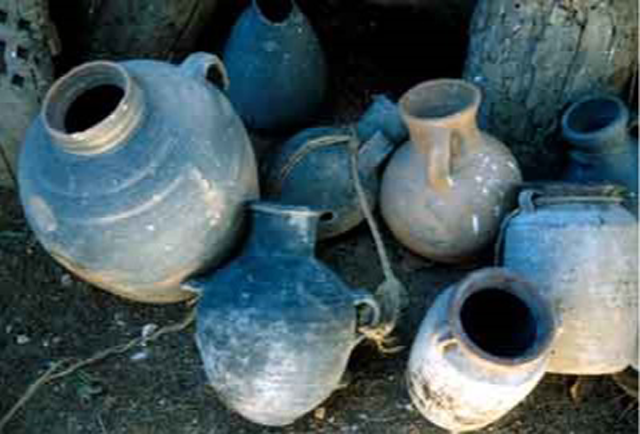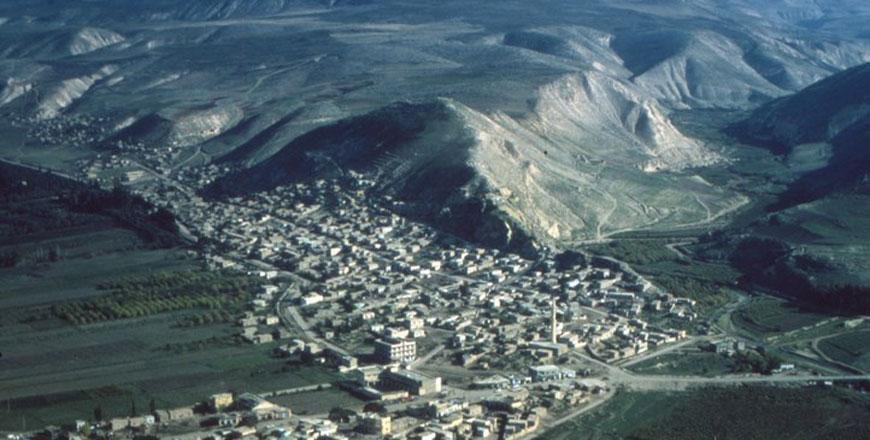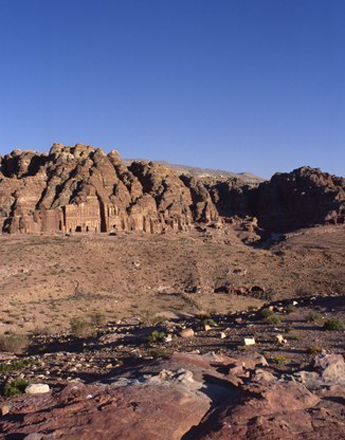You are here
Evolution of Islamic pottery in Jordan
By Saeb Rawashdeh - Oct 10,2024 - Last updated at Oct 10,2024

Group of water and oil storage vessels, probably from northern Jordan, early 12th century (Photo courtesy of Karak Resources Project)
AMMAN — Initially, the advent of Islam during the 7th century AD to the Levant did not cause much of disruption to urban and rural life. Politically, the change was significant, but regarding the life of ordinary people changes would take a gradual course.
Over the next five centuries, however, a range of cultural innovations evolved in response to growing community aspirations, of which “Islamification” was one.
"With the pottery, two broad trends can be identified: An unbroken continuation and refinement in the wares and forms from Byzantine times and, from the 8th to early 9th centuries AD onwards, the appearance of new styles and techniques inspired by rapid developments in ceramic technologies across the Middle East," noted the professor Alan Walmsley from Macquarie University in Australia.
Walmsley added that in Jordan, these new styles only slowly gained widespread acceptance in the highlands; rather, a long tradition of locally produced wares continued to dominate.
Unlike in the mountains, however, the pottery profiles at sites in the Jordan and Arabah Valley show that the adoption of Islamic glazed and cream fabric wares occurred at the same time traditional forms were retained.
The crossover between traditional and new ceramic types in the Rift Valley provides a crucial typo-chronological key with which to securely date the local early Islamic wares in the highlands, resulting in an inclusive pottery typology that covers the 7th to 11th centuries AD.
"Early Islamic pottery in Jordan can be better understood by focusing on two major themes: first, wares and technology and second, forms and function," Walmsley said, adding that changes in these four features serve to map out a chronological progression, which reflect evolving social preferences.
Three distinct regional clusters can be identified for Jordan: the northern hills with Jerash as the primary centre; a central cluster of Balqa and Ma’ab; and a third south of the Wadi Mujib with a centre at Aqabah (Aylah).
"In all three clusters, fast-wheel technology was applied in producing utilitarian objects-notably jars, jugs, cups, cooking pots and casseroles, bowls, lids and small basins-with smooth or ribbed [rilled] surfaces. Large vessels such as mixing basins and storage jars were handmade with rims finished on a slow wheel," Walmsley underlined, adding that greater regional individuality can be seen in the clay selection from local sources, kiln firing conditions and decorative preferences.
"In the North Jordan cluster, clays shared a common recipe across vessel types: Well mixed, slight to moderate grits, with some larger lime inclusions. The primary variable factor was coarseness, depending on purpose. Firing in updraft kilns resulted in a thin, hard, brittle fabric coloured a range of reds, browns, and dark grays. Handmade basins and storage jars were gray.
Decoration in the 7th to early 8th century favoured comb incision, rim pinching, impressed bands and white painted motifs, but by the mid-8th century AD painted abstract designs were applied to fine wares in white and reddish-brown tints, with red dominating in the 8th to 10th centuries AD," Walmsley elaborated.
Comb incision on large vessels decreased, but deep-cut geometric designs featured on handmade bowls. The Balqa ´cluster shared many features with the Jerash cluster, although there is refinement in clay preparation, firing and painted decoration. In a sign of independent production centres, Alawneh has shown that there is a “high degree of chemical disparity” between the two clusters, the professor said, adding that for finer wares, Balqa consumers favoured light colours in cream, beige and browns, occasionally with a cream slip.
"From the mid-8th century and 9th century Balqa ceramics excelled in a series of high-quality, high-art, and elegant bowls in a cream-to-light orange ware over painted with intricate geometric patterns in red," Walmsley pointed out.
Furthermore, the South Jordan cluster shared many technological features with the north and central clusters until the 8th century, after which its pottery matched styles in the Naqab, the scholar claimed, adding that using chemical and petrographic evidence, Alawneh and E. Holmqvist have identified two distinct groups in south Jordan: A shared tradition in Jibal and Shara mountains, and a second at Aylah.
"The mountain wares were made from local clays only slightly prepared. Colours were light, from cream to brown and pink to mid-red. Decoration favoured incisions in straight and wavy lines and finger impressed bands," Walmsley underlines, adding that few rare examples of painted jars had red lines.
In Aylah, an early glazed tradition appeared in the eighth c. as part of a technological innovation in fine table wares. In the second half of the 10th century AD, handmade pottery re-emerged in chaff-tempered cooking and domestic wares.
"Earlier Islamic Jordan saw significant developments in the forms and function +of pottery as changing tastes and developing technologies introduced new assemblages to households," Walmsley explained, noting that historically, the path of cultural continuity, change and innovation occurred in three stages, different to the dynastic history of the 7th to 11th centuries.
These stages are: 7th and 8th centuries (Rashidun, Umayyad and early Abbasid), with archaeologically significant earthquakes in AD 659/660 and a second more powerful one in AD 749, the professor said.
"Stage 2 from 9th to mid-10th centuries, a period of significant political and economic change that focused on Balqa’, the far north, and the far south of Jordan, but elsewhere activity was continuous and subdued, but not absent. Stage 3: mid-10th and 11th centuries (Fatimid and Saljuq), during which resistance measures were undertaken by the local tribal leaders in Jibal and Sharah to prevent political and sectarian intervention by neighbouring power groups," Walmsley underscored.
Related Articles
AMMAN — Tell Shuneh Shamaliyyeh is located in the northern part of the eastern side of the Jordan Valley in Irbid Governorate. The Jord
AMMAN — Wadi Rum is a desert on the southern part of Jordan also known the Valley of Moon.
AMMAN — Brigham Young University from Provo initiated Wadi Mataha project in Petra and they tested the theory generated from the previ

















